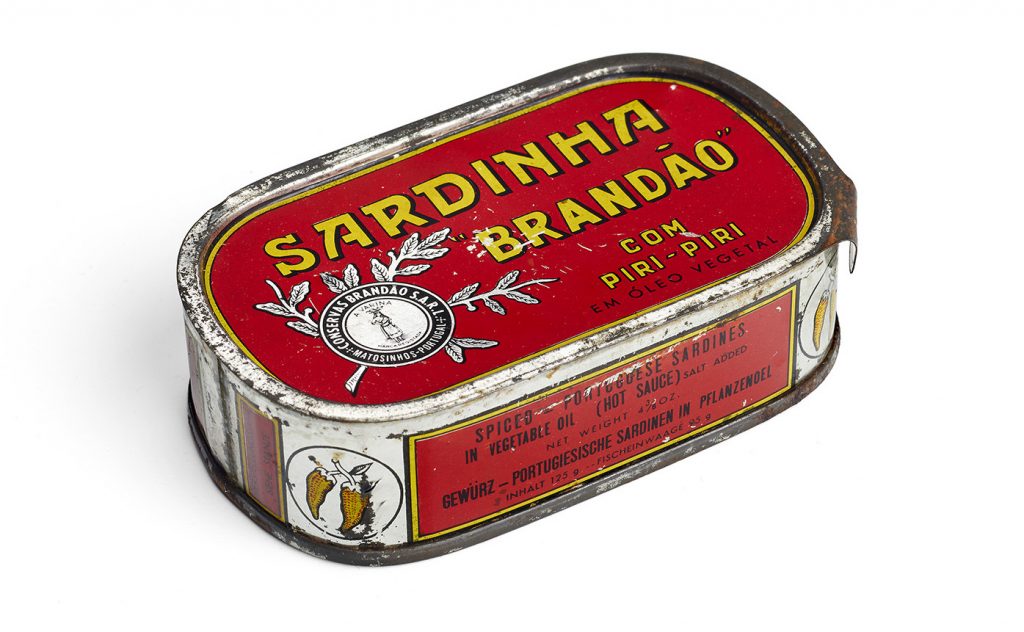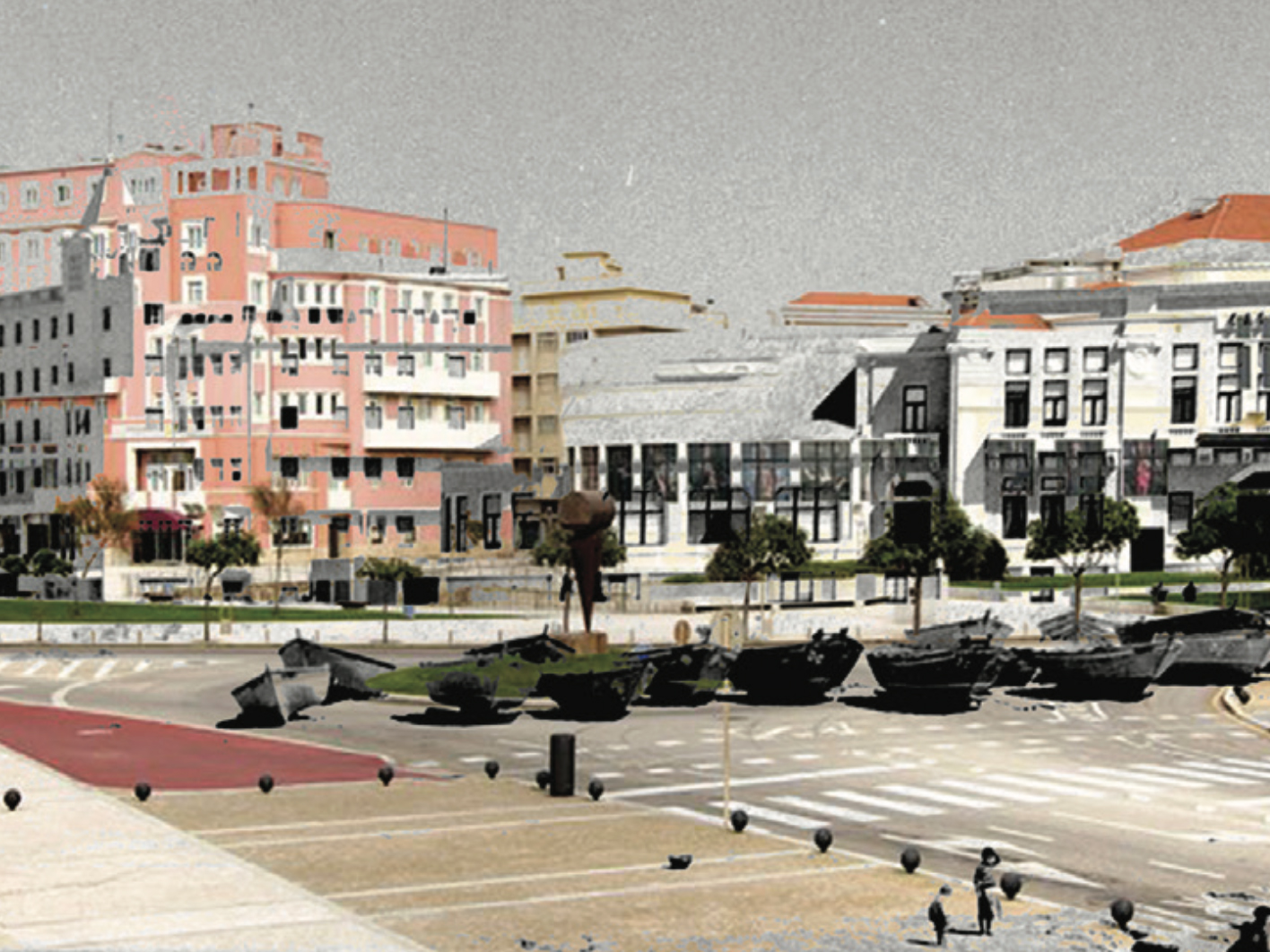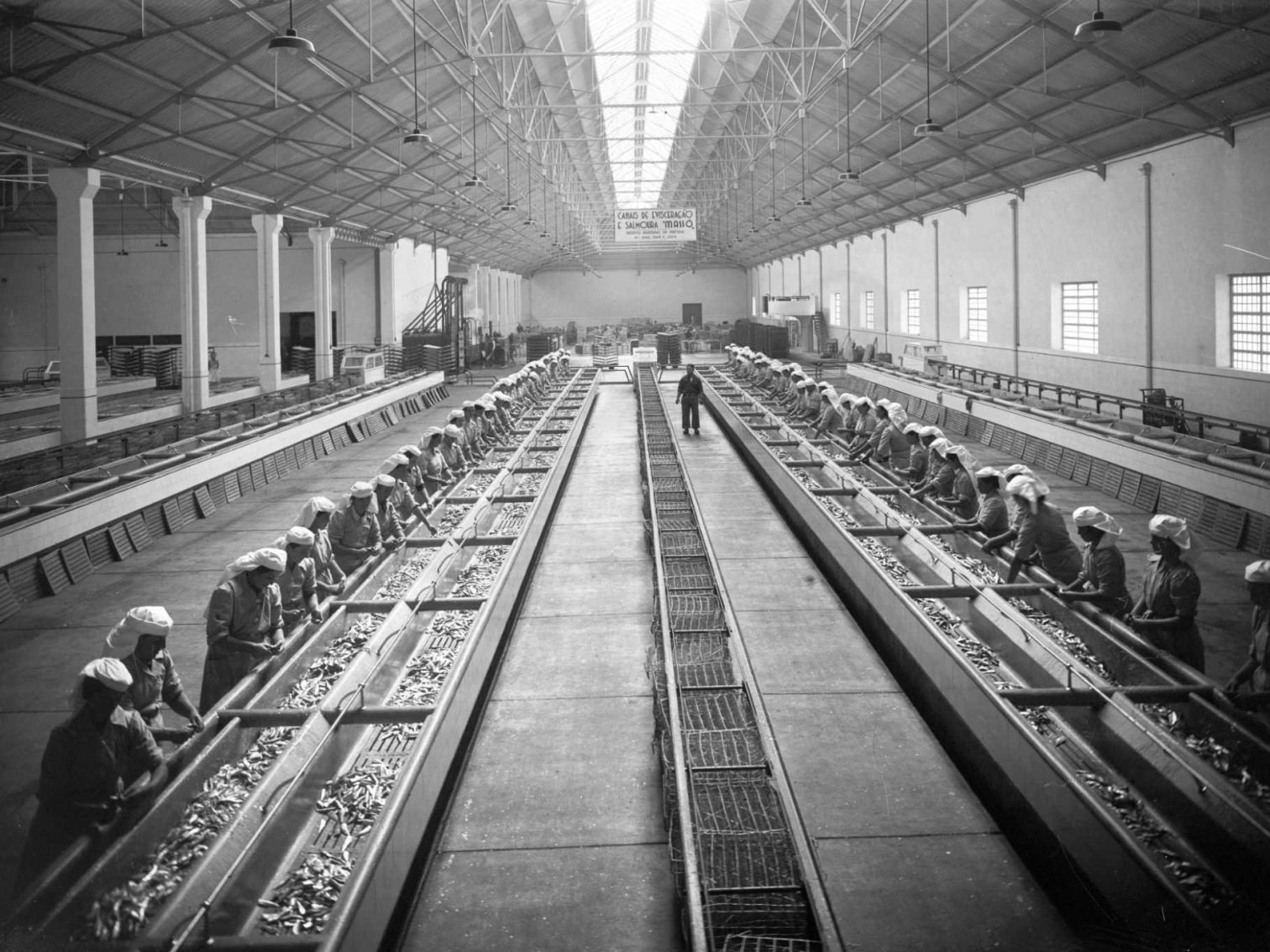Architecture in a Can
The study of canned sardines reveals multiple architectural connections between ports, cities and factories throughout the Atlantic. By looking at a single can, a large network of built practices becomes apparent. This analysis focuses on the city of Matosinhos, a place where the Atlantic upwelling provides a favorable environment for pelagic fish such as sardines. Matosinhos, as a case study, brings together an array of ideas, from the links between natural environments of fish species and hydrographic dynamics to contemporary urban design practices and Alvaro Siza’s reminiscences of the city of his youth. Through fishing architecture, we can depict the spatial, environmental and cultural expressions of the history of fishing and the development of the first industrialized food.[1] In order to seize the complexity of a specific object that has been studied in various disciplinary fields—sardine fishing and canning—the built environment can represent a common ground to understand the social, natural, industrial and urban dimensions of a significant activity of sea resource exploitation through the decades.
The transformation of fishing techniques initiated by industrialization has been intertwined in continuous dispute with tradition and regulation, between fishermen and scientists, towards establishing a balance between economic expectations and ecological limits. Fishing quotas, which attempt to quantify how much fish can be caught within a fishing season granting the optimal sustainable yield of stocks biomass, are one such contentious issue. The fishing industry itself is in constant change: introduction of synthetic fibers led to the creation of stronger and wider nets, steam and diesel propulsion allowed fishing boats to go further and faster while pushing heavier nets, and electronic devices for detecting fish schools and artificial refrigeration transformed the spatial distribution of fishing. In the 1970s, fish captures reached a peak that unbalanced ecological systems. What are the effects and impacts of these processes on cities and architecture?
Taking the urban history of Matosinhos as an example, we see the role of fishing industry in the transformation of an ancient fishing town in a primary region of Porto’s metropolitan system. The Portuguese canning industry moved north to concentrate in the harbour built in Leixões during the second half of the nineteenth century. This process reflects the history of Portuguese slow industrialization and the emergence of strong state policies on the economy. During Estado Novo (1933-74) state interventions had a particularly political bias and fisheries played their part in the construction of a nationalist narrative. In Leixões, existing infrastructures like the railway and the harbour preceded urban planning initiatives. These factors became key to the prominence of the canning industry in the area, which benefited from Portuguese neutrality during World War II.
The dynamics of the economy led to concentration, as fewer canneries gradually produced more cans: from more than 200 canneries established in Portugal (most of them in Setúbal) at the end of the Great War (1914-18), less than 50 were installed in the surroundings of Leixões during World War II (1939-45) while being more productive. The current 4 that are still operating in Matosinhos produce a greater number of cans annually.[2] It is clear that different urban patterns are generated in relation to this process of concentration.
The history of the Ramirez factory demonstrates the dynamics involved in this process. Sebastião Ramires (1898-1972) took advantage of his close connections with the Estado Novo regime—including his role as minister of commerce and industry (1932-36)—to reinforce his family business, moving it from its original premises in Vila Real de Santo António in the south of Portugal to Matosinhos in the north. While this geographical movement was happening and political allegiances developed, technical shifts were also taking place within the production line. Step by step, the location of caught and canned fish changed in proximity from south to west coast fishing grounds, and thus the ecological impact of the factory accompanied political and economic policies. The history of the Ramirez factory is an example of strategies for maintaining and modernizing a family business through more than 150 years, and also illustrates the proximity of the fishing sector to the corporative Portuguese state.
If politics and economy can explain one part of the concentration process, biology and ecology help make sense of natural dynamics in relation to anthropic interventions. These intertwined phenomena suggest the need to rethink the relation between cities and marine ecologies. Eventually, the production of canned sardines in the north of Portugal led to an impact on the sardine population, as noted by Maria Eugénia Mata:
As fisheries and canning were labour-intensive sectors, seaports were nests of marine and industrial jobs that supported local commerce, exports, consumption, standards of life, and intensive urban growth phenomena. Major threats to fisheries were also major economic threats to local urban activities. At the same time, business prosperity and growth were perverse to ecosystem destruction, and were severe threats to marine-life.[3]
The quality of Atlantic sardine captured in the Portuguese coast lead to intense exploitation, threatening a resource that fueled an important sector of the economy. Didier Gascuel has demonstrated that in the fishing industry, laws of economy don’t apply as in industrial capitalism.[4] Greater investment on fishing boats, increasing fishing pressure, leads eventually to poor captures and unbalances the ecological system which involves fish and fishermen. There is a threshold for catches to grow before the collapse of fish populations, and once the fish population is collapsed, the economic and urban context that propelled the growth of fisheries also collapses.
In the case of Matosinhos, the politically induced move of Portuguese canning industries towards North had a strong impact on sardine populations. Plenty of canning industries later collapsed, in part induced by technological and economical dynamics, but some industries recouped and their total production is larger than before, eventually using frozen and imported fish. Unlike the canneries, the fisheries economy continues to slow, and their impact on the ecosystem is stronger since the equilibrium is a long time lost.
Fishing Architectures in Matosinhos
A straightforward relationship between architecture and sardine fisheries can be observed in the typological development of canning factories. In the late nineteenth century, canneries were installed under industrial sheds around a patio, in direct relation to the shore and loading docks but also with good connection to infrastructures as the railway to secure exports. The pragmatism of industry only allowed for architectural expression in the form of eclectic decoration, often highlighting office spaces and brand insignias. Powered by steam, these factories attracted workers’ and fishermen’s housing in a process of unplanned urbanization. This was often followed by disaster (fire or flooding) districts to then be reorganized in a planned fashion. On the Portuguese coast, sardine fisheries developed in parallel to tourism, often generating conflicts and segregation along the seascape. In Espinho, the vertiginous trajectory of the Brandão Gomes company is a telling example. They expanded their production by spreading facilities along the coast in São Jacinto (Aveiro), Matosinhos, and Setúbal to secure catches capable of fulfilling the commercial demand for its products, as the fishing capacity of a single operational unit (from fishery, to landing beach or dock, to factory) was limiting its expected growth. These limitations are telling of the fragile Portuguese capitalism and technology, but they also reveal the mismatch between industrial rationale and the limits of local natural resources. The ecology of fish schools, often captured with rudimentary fishing techniques, was hard to reconcile with pre-Taylorist production methods.
After the exponential growth of improvised factories in Setúbal fueled by the Great War, a new type of cannery emerged. Archival images show different production units in Setúbal and Matosinhos. Adapted warehouses contrast with rationally designed industrial buildings that have high ceilings and large spans with natural light, ventilation and the capability to host assembly lines.5 The social and political unrest of the early twentieth century, often culminating in strikes, contributed to undermine Setúbal as a privileged location to foster the industrial concentration. When the canning industry became concentrated in Matosinhos, architects were called upon to improve the factories’ design. In an article published by the national canning corporation shortly after World War II, ARS Arquitectos advocated for a “modern canning factory” as a tool to increase production.[6]
The space of the “modern canning factories” was to be organized following the dynamics of production in compact volumes: fresh fish coming from the boats was delivered in a loading dock, sardine cans were dispatched through a different one; employees (mostly men) accessed it through a main entrance, workers (mostly women) were directly connected to the production line through an exterior gate. The introduction of machinery and systems designed for sardine processing also contributed to structure the factories’ spatial configuration. With the introduction of the Massó evisceration system in Portugal in the 1940s, a canal of flowing water generated a liquid assembly line both washing the fish and the tins while connecting the different stages of production.
The conservative bias of Portuguese politics prevented the adoption of the freezer revolution that transformed fish processing in the post-war northern European countries. The introduction of artificial refrigeration in Portugal aimed to balance the seasonal effects of fisheries rather than the consumption habits.[7] The challenge of canneries was to get the fish in the can as soon as possible, in order to preserve its qualities and flavour. Hence, factories were built in the immediacy of the fishing ports, shortening the fish’s trajectory from the sea to the can. Only later, with European funded investments at the end of the twentieth century, would new freezing and refrigeration equipment (in the factories, boats, and lorries) allow factories to release high-valued land by the shore (recapitalizing the companies through real estate) and settle on peripheral industrial sites.
Nowadays, only four canning factories remain in Matosinhos. Pinhais and Portugal Norte, examples of the modern and premodern factories, both still operate in their original site and use traditional methods (aimed at the gourmet market). La Gondola remains in a generic industrial shed in Perafita, in proximity of the port. Ramirez, the leading brand, recently relocated from Perafita to Lavra to a brand-new building a short distance from the international airport. For their new facilities, Ramirez invested in architecture to market their operations and hired the firm Mofase to design a building accordingly. The entrance has a large publicity sign advertising its historical legacy — “Ramirez 1853” — and the shape of the corrugated aluminum building emulates a stack of gigantic cans. The result is an embarrassing contradiction if read under the spell of Venturi, Scott Brown and Izenour words, both a duck and a decorated shed.[8]
The urban history of Matosinhos suggests a new gaze on the history of Portuguese architecture. In the last decades of the twentieth century, canning factories lost financial support from the state and many didn’t survive the modernization process, leaving ruins, voids, and memories that are the origin of powerful myths. As a local historian duly noticed:
Matosinhos is proud of its land, which was, in a near and brilliant period, a land of fishermen. But the fishermen, diminished by an economic system which controlled prices, keeping them low, were one of the most exploited social groups. They are in the origin of the oligopolies which launched the conserving families into the society of the time, ending up by attributing themselves with other activities. The poverty which was often widespread among the families, who took their wives and daughters to work in the conserving factories, was the other side and the strong reason for the myth created around them. [9]
Álvaro Siza, born in Matosinhos in 1933, started his career designing a group of houses for a sardine-fishing captain. A number of his early works are related to the reorganization of the port and souring urban areas. In an interview from 1990, [10] Siza recalls memories of the city’s transformation, where the void left by the canning industries gave place to new urban developments fuelled by real estate and European funding:
Matosinhos from thirty, forty years ago… The primitive trawlers, the illuminated masters, the works of the port and the engineers (…) Those who lived in the sea, or looking at the sea, were forcibly tidied up in the Fisherman's Quarter in pink houses with oriental eaves. The tenements [11] overcrowded during the campaign, then abandoned, the pawnshops, drunken sailors of the tankers, the fires of the Mobil depots, near the sawmill, the first bars, prostitution houses, Senhor de Matosinhos festivities with paper and wood bows , 'factory women', in bands, provoking singing, also the Winery, warehouse of workers and disease. This Matosinhos has disappeared, transformed by itself, also for me, by my eyes.
Despite the trawlers, Siza’s memories make almost no mention to fishing architectures. He does not refer to Matosinhos Municipal Market, designed by ARS Arquitectos in 1930s and completed in 1952, or to canning factory projects by Januário Godinho or António Varela. He simply draws their ruins. In the early 1990s, Siza was responsible for the urban plan of Matosinhos Sul, the area where most of the canning factories operated, and established the parameters for its transformation into an upper class neighbourhood. Siza marked several factories as monuments to preserve, as well the path of the former railway access to the port as a pedestrian path, keeping traces of the place memory. Despite the plan’s recommendations, most of the buildings were simply demolished, though a few still stand operating as supermarkets.
The canning chapter of Matosinhos’ urban history is fighting to keep its physical legacy along the ongoing real estate development. Matosinhos is a place where the canning industry reveals one specific aspect of the broader concept of fishing architecture. Fishing architecture ranges from dock quays to fishermen’s shacks, large infrastructures to processing facilities of which the canning factories are only one example. These architectural types emerge in relation to various fish species wherever there are fish and fisherman, and connect both sides of the Atlantic into an international network of architectural and urban formations. This process is closely linked to the dynamics of logistics and the economy of contemporary society, but also relates to the intimate connection between sardine fishing and processing that exists in coastal territories thanks to their specific marine ecologies. The history of coastal architecture should be addressed acknowledging multiple spatial and temporal scales. Architecture exists at the hinge of interactions between human and non-human systems. The case of canned sardines shows that the assessment of architecture requires multi-layered models of analysis, comprising information from disparate disciplines such as marine biology and ecology, geography, political and cultural histories, economy and social sciences, in order to reach a fair environmental perspective of its implications. If we aim to reinvent the relationship between architecture and the environmental predicament, we must reassess those strategies and problems within architectural history.
Article by André Tavares and Diego Inglez de Souza originally published in Pidgin magazine Nº 27
[1] Pascal Brioist and Jean-Christophe Fichou ‘La sardine à l’huile ou le premier aliment industriel Nicolas Appert et Joseph Colin : une filiation douteuse’ Annales de Bretagne et des Pays de l’Ouest, Vol. 119, n° 4 (2012), 69-80.
[2] According to the a combination of statistics provided by the National Institute of Statistics (INE) and the National Agency of Fish Canning Industries (ANICP).
[3] Maria Eugénia Mata “Environmental challenge in the canning industry: The Portuguese case in the early Twentieth century” Historical Social Research vol. 35-4 (2010):351-372(352).
[4] Didier Gascuel Pour une révolution dans la mer: De la surpêche à la résilience Arles: Actes Sud, 2019.
[5] Hugo Nazareth Fernandes ‘Em Busca de Luz, Ar e Claridade’ in De Pé Sobre a Terra. Estudos Sobre a Indústria, o Trabalho e o Movimento Operário em Portugal, Bruno Monteiro and Joana Dias Pereira eds., Lisboa/ Porto: Instituto de História Contemporânea, Universidade Nova de Lisboa and Instituto de Sociologia, Universidade do Porto, 2013.
[6] “Uma fábrica de conservas moderna” Conservas de Peixe 6 (1946):14-15.
[7] Karl Otto Ellefsen, Tarald Lundevall North Atlantic Coast – A Monography of place Oslo: Pax Forlag, 2019.
[8] Robert Venturi, Denise Scott Brown and Steven Izenour Learning from Las Vegas. Cambridge: MIT Press, 1972.
[9] Maria do Carmo Serén ‘Mythologies of fishing and fishermen from Matosinhos’ in Uma cidade assim: Fotografias de Larry Fink e Bruno Sequeira (Matosinhos: Câmara Municipal, 1996), 130-144 (137).
[10] Álvaro Siza “Interview” in José Salgado Alvaro Siza em Matosinhos (Matosinhos: Câmara Municipal / Pelouro da Cultura e do Turismo, 1990), 135-136.
[11] Ilhas, the main workers housing typology in Porto, consisting of small units sharing sanitary facilities built along a corridor in the backyards of a XVIII or XIX century urban house.


